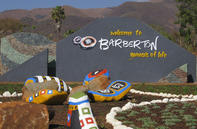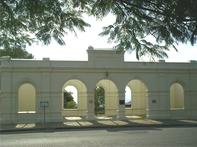Barberton's Diverse Population
The inhabitants of Barberton are as diverse as its storied past. In the late 1800s, the Swazi nation during the reign of King Sobhuza I spanned from Pongola up to Barberton. As it is with most positions of power, Sobhuza’s reign came to an end and a new ruler, King Mswati II, who was also known as the ‘fighter king of the Swazis’, assumed the high seat of royalty.

King Mswati strove to unify the different tribes, creating one people known as the bakaMswati, which mean “the people of Mswati”. This ideal did not immediately come to fruition and certain clans like the Mbayi tribe, who were also known as the Maseko people lived along the mountainous region of Barberton.
The Mbayi people were known to erect loose stones in piles that were two metres in diameter and one metre in height. These stony structures were found along the slopes of Mokhanjwa Mountain all the way to the mountains of Hectorspruit. There are many theories as to why the Mbayi people stacked stones in such a deliberate manner.
One particular theory, held by early settlers to the area, was that the Mbayi people did this as an act of land cultivation. However, there was no evidence present of bush clearing, to indicate that the soil was indeed being prepared for vegetation. Nonetheless, these interesting man-made formations add to Barberton’s rich heritage.
Today, Barberton’s population is a cosmopolitan mix of people with European, African, and Asian ancestry.
Barberton's Museums

If a glance into the past piques your interest, look no further than Barberton’s selection of museums. Technically the Barberton Museum is comprised of smaller museums such as the Blockhouse, Belhaven House Museum, Stopforth House, and Fernlea Museum to name a few. These museums can be visited individually or as part of the aptly named Heritage Walk. So when you find yourself in Barberton, be sure to step into the colourful past of a small town that packs a big cultural punch.
While in the old gold mining town add a dash of continuity to your visit with a walk through Barberton’s streets and visit historic buildings such as the Lewis and Marks Building (1887), which is the town's first double-storey building, and the neo-gothic Masonic Lodge (1884), which was built as the Union Church only to be taken over by the Freemasons in 1887.
For the more artistic inclined visitor, a definite must-see is the Stone Garden by Nukain Mabuza. Mabuza gained a large international following in the 70s and early 80s with his colourful rock paintings, which he affectionately called the Garden of Flowers. After his passing in 1981, the Stone Garden fell victim to environmental elements as well as a lack of maintenance. Today, there is not much remaining of Mabuza’s outdoor artwork yet the site is still worth a visit. Mabuza’s legacy lives on in the countless local and international artists who have been inspired by his work. One such artist is the playwright, Athol Fugard, whose play The Painted Rocks at Revolver Creek is based on Nukain Mabuza’s life as a farm worker and self-taught artist. This play premiered in New York in 2015 and received critical acclaim.
Sir Percy Fitzpatrick

Legend has it that Sir Percy Fitzpatrick, the author of a South African literary treasure, Jock of the Bushveld, was inspired by the surrounds of Barberton and his personal story as a local. The story is set in the 1880s, against the backdrop of the gold rush of South Africa and follows the relationship between a young Fitzpatrick and his beloved dog, Jock. Fated to meet, Fitzpatrick rescued Jock from a potential watery end, when his presumed owner at the time attempted to drown him for being the runt of the litter.
If you are a devoted animal lover or simply enjoy reading a well-written book, look no further than Jock of the Bushveld. It is a story, initially written for Fitzpatrick’s young children, that will charm readers as they follow him on his adventures with his trusty dog through Barberton’s landscape and gold mining past.
For those who are stalwarts of Sir Percy Fitzpatrick’s book, the town hall of Barberton is furnished with a statue of Jock. Making for a great photo opportunity to cement your status as an avid Jock of the Bushveld fan. After all, it is easy to understand why a book that has never been out of print would be memorialised in a statue.
Jock of the Bushveld
Jock of the Bushveld is the ultimate man’s best friend story. Detailing the true relationship between Sir Percy Fitzpatrick and his dog, Jock, a Staffordshire bullterrier, Jock of the Bushveld is bound to warm many a dog lover’s heart. Jock was a loyal and devoted companion, as he accompanied his owner, on his travels through the gold mining landscape. Spoiler alert: readers of the South African classic will know the ending is not entirely pleasant. So for those who need closure, do visit the statue of Jock sculpted by Ivor Mitford Barberton (donated by Mrs ‘Mackie’ Niven), which is outside of the Barberton town hall, as well as the gravesite of his loving owner, Sir Percy Fitzpatrick, which can be seen from the lookout tower at Kirkwood.
If you are intending to overnight or extend your stay in Barberton, additional art dedicated to Jock can be viewed from inside Diggers Retreat such as a tableau of scenes from Jock's life along the walls, painted by itinerant artist Frederick Genal.
 The cultural heritage of the Mpumalanga province is both varied and exciting. The Ndebele beadwork and house painting in the north-west, the...
The cultural heritage of the Mpumalanga province is both varied and exciting. The Ndebele beadwork and house painting in the north-west, the...